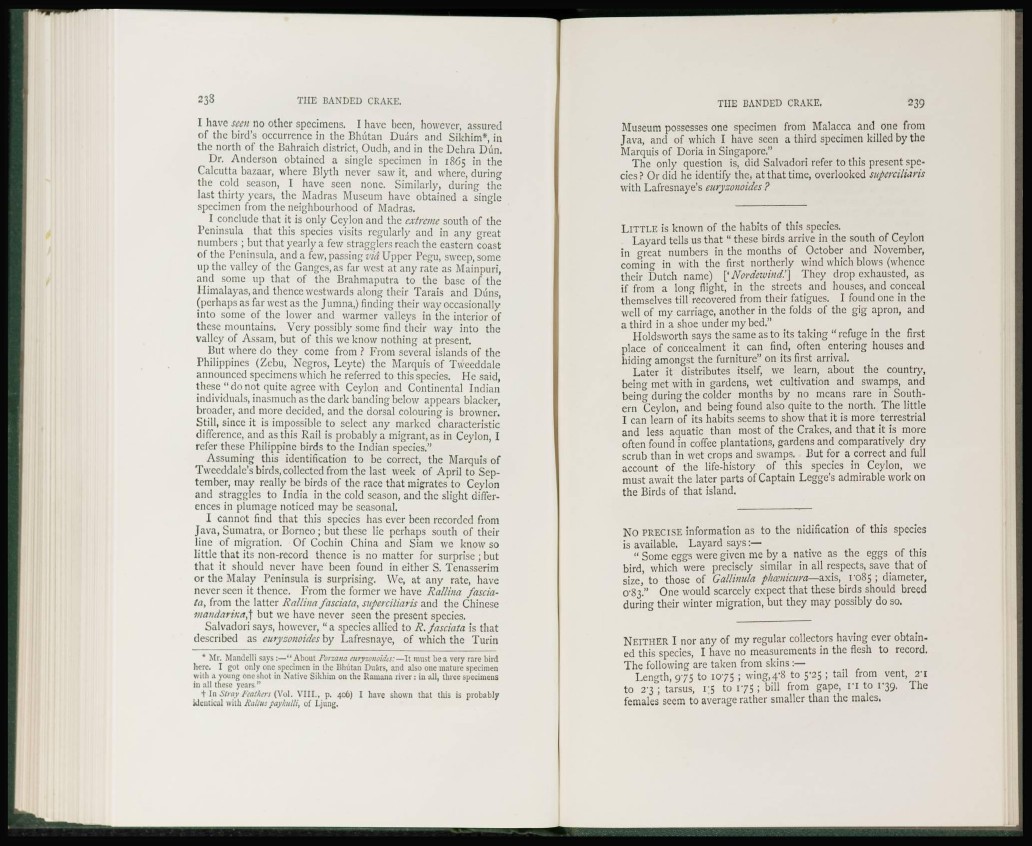
I have seen no other specimens. I have been, however, assured
of the bird's occurrence in the Bhutan Duars and Sikhim*, in
the north of the Bahraich district, Oudh, and in the Dehra Dun.
Dr. Anderson obtained a single specimen in 1865 in the
Calcutta bazaar, where Blyth never saw it, and where, during
the cold season, I have seen none. Similarly, during the
last thirty years, the Madras Museum have obtained a single
specimen from the neighbourhood of Madras.
I conclude that it is only Ceylon and the extreme south of the
Peninsula that this species visits regularly and in any great
numbers ; but that yearly a few stragglers reach the eastern coast
of the Peninsula, and a few, passing via Upper Pegu, sweep, some
up the valley of the Ganges, as far west at any rate as Mainpuri,
and some up that of the Brahmaputra to the base of the
Himalayas, and thence westwards along their Tarais and Duns,
(perhaps as far west as the Jumna,) finding their way occasionally
into some of the lower and warmer valleys in the interior of
these mountains. Very possibly some find their way into the
valley of Assam, but of this we know nothing at present.
But where do they come from ? From several islands of the
Philippines (Zebu, Ncgros, Lcyte) the Marquis of Tweeddale
announced specimens which he referred to this species. He said,
these " do not quite agree with Ceylon and Continental Indian
individuals, inasmuch as the dark- banding below appears blacker,
broader, and more decided, and the dorsal colouring is browner.
Still, since it is impossible to select any marked characteristic
difference, and as this Rail is probably a migrant, as in Ceylon, I
refer these Philippine birds to the Indian species."
Assuming this identification to be correct, the Marquis of
Tweeddalc's birds, collected from the last week of April to September,
may really be birds of the race that migrates to Ceylon
and straggles to India in the cold season, and the slight differences
in plumage noticed may be seasonal.
I cannot find that this species has ever been recorded from
Java, Sumatra, or Borneo ; but these lie perhaps south of their
line of migration. Of Cochin China and Siam we know so
little that its non-record thence is no matter for surprise ; but
that it should never have been found in either S. Tenasserim
or the Malay Peninsula is surprising. We, at any rate, have
never seen it thence. From the former we have Rallina fasciala,
from the latter Rallina fascia/a, supcreiliaris and the Chinese
mandarir.a,\ but we have never seen the present species.
Salvadori says, however, " a species allied to R. jasciata is that
described as curyzonoides by Lafresnaye, of which the Turin
* Mr. Mandelli says :—"About Porzana ntrytonoides:—It must be a very rare bird
here. I got only one specimen in the Bhutan Duars, and also one mature specimen
with a young one shot in Native Sikhim on the Ram&na river: in all, three specimens
in all these years "
t laStrtty feathers (Vol. VIII., p. 406) I have shown that this is probably
identical with Raltus /aykulli, of Ljung.
Museum possesses one specimen from Malacca and one from
Java, and of which I have seen a third specimen killed by the
Marquis of Doria in Singapore."
The only question is, did Salvadori refer to this present species
? Or did he identify the, at that time, overlooked supcreiliaris
with Lafresnaye's curyzonoides ?
LITTLE is known of the habits of this species.
Layard tells us that " these birds arrive in the south of Ceylon
in great numbers in the months of October and November,
coming in with the first northerly wind which blows (whence
their Dutch name) [' Nordetviud.'] They drop exhausted, as
if from a long flight, in the streets and houses, and conceal
themselves till recovered from their fatigues. I found one in the
well of my carriage, another in the folds of the gig apron, and
a third in a shoe under my bed."
Holdsworth says the same as to its taking " refuge in the first
place of concealment it can find, often entering houses and
hiding amongst the furniture" on its first arrival.
Later it distributes itself, we learn, about the country,
being met with in gardens, wet cultivation and swamps, and
being during the colder months by no means rare in Southern
Ceylon, and being found also quite to the north. The little
I can learn of its habits seems to show that it is more terrestrial
and less aquatic than most of the Crakes, and that it is more
often found in coffee plantations, gardens and comparatively dry
scrub than in wet crops and swamps. But for a correct and full
account of the life-history of this species in Ceylon, we
must await the later parts of Captain Legge's admirable work on
the Birds of that island.
NO PRECISE information as to the nidification of this species
is available. Layard says :—
" Some eggs were given me by a native as the eggs of this
bird, which were precisely similar in all respects, save that of
size,' to those of Gallimda phcenicura—axis, 1-085 ; diameter,
0-83'." One would scarcely expect that these birds should breed
during their winter migration, but they may possibly do so.
NEITHER I nor any of my regular collectors having ever obtained
this species, I have no measurements in the flesh to record.
The following are taken from skins :—
Length, 975 to 1075 ; wing,4'8 to 5-25 ; tail from vent, 21
to 23 ; tarsus, i;5 to 175 ; bill from gape, r i to 1-39. The
females seem to average rather smaller than the males.